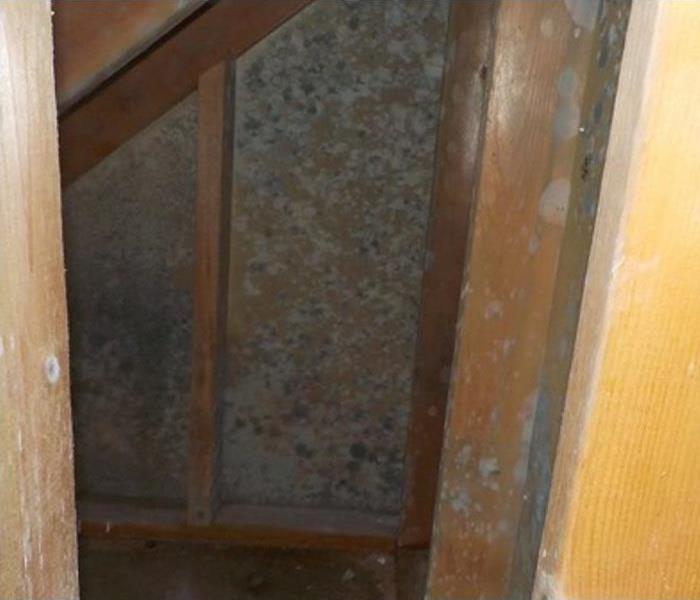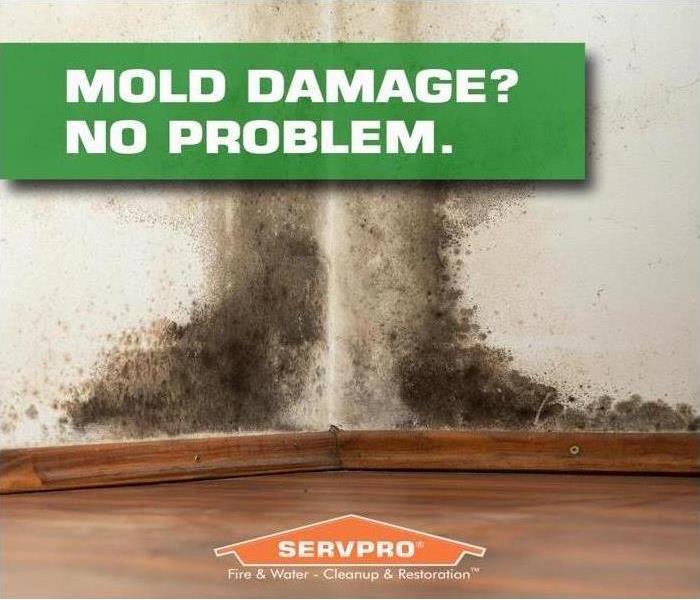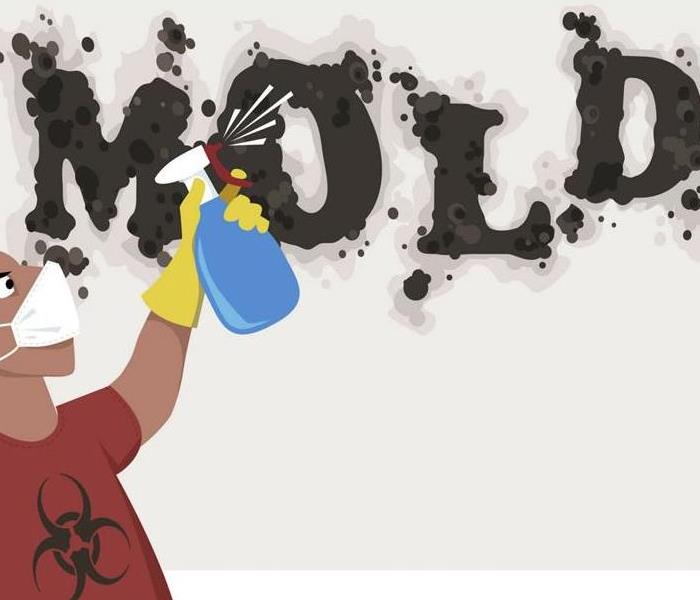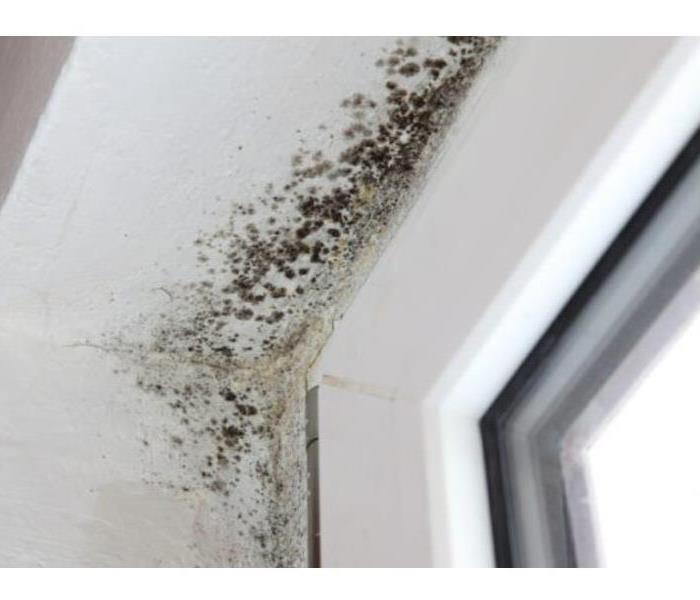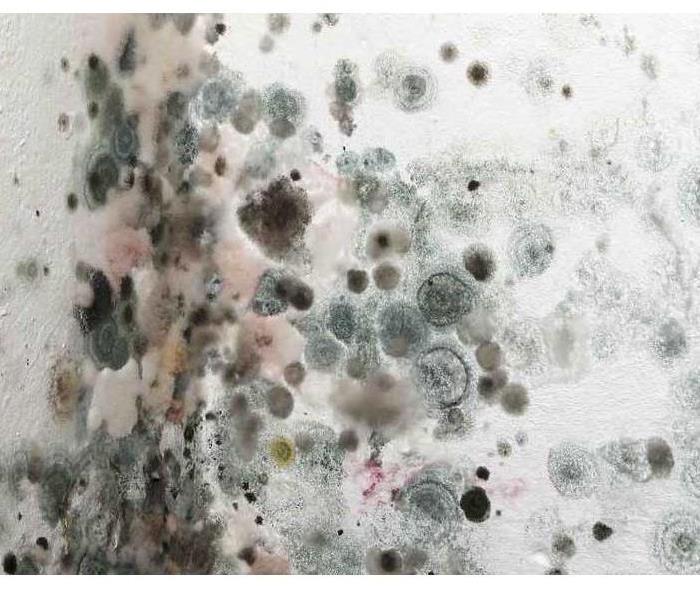Archived Mold Remediation Blog Posts
Steps to Take After Discovering Mold at Home
3/14/2025 (Permalink)
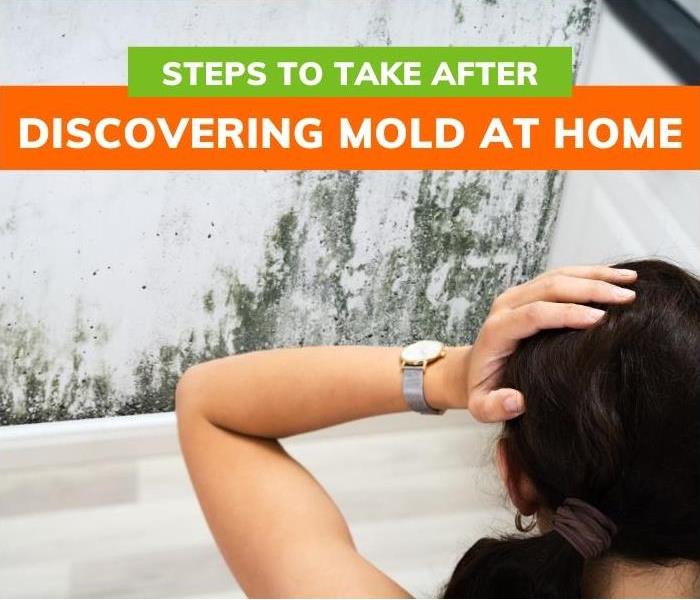 Woman Looking At Mold
Woman Looking At Mold
Steps to Take After Discovering Mold at Home
Discovering mold in your home can be distressing, but addressing it promptly and methodically can help prevent additional damage and risks to your family's health. Mold conditions become manageable by identifying the cause, limiting the spread, and using safe cleaning methods. A proactive approach to locating and treating mold infestations ensures a healthier home environment for the entire family.
Calmly Assess the Situation
Discovering mold in the home can be anxiety-provoking, but remaining calm makes it easier to handle the problem methodically. Without touching the mold, inspect the infected area to see the extent of mold growth and whether moisture is present. Before deciding on steps to take after discovering mold at home, determine if the infestation is limited to one section or has spread across several areas.
Conduct a “sniff” test to detect musty odors. This smell often indicates hidden mold, such as underneath carpets or behind furniture. Consider potential causes in the structure, such as flooding, leaks, or high humidity. Avoid disturbing the areas as much as possible to prevent microscopic mold spores from becoming airborne and spreading.
Locate Moisture Sources
Mold thrives in damp areas and humid conditions. Finding the source of moisture is vital to preventing further growth. Inspect the building, looking for plumbing leaks or water entry points in window frames or doors. If the building was involved in a fire, the fire damage cleanup might include removing excess moisture and mold. Examine the ceiling and walls, looking for stains indicating water leaks through the roof or inside the walls. Additionally, check the flooring for signs of warping.
Look for signs of mold damage in areas with frequent condensation, such as kitchens and bathrooms. Use a moisture meter tool to detect hidden moisture in walls, ceilings, and small areas such as crawl spaces. Address ongoing moisture issues, such as water leaks, before tackling the mold cleanup.
Limit Spore Spread
Mold spreads through invisible spores that float through the air, requiring careful handling to reduce the risk of further contamination. Avoid using the HVAC system or fans until the mold is safely contained. Cover vents and keep doors shut to close off the affected area. To seal the area off, use plastic sheeting taped to walls and ceilings for heavily contaminated spaces.
To prevent disturbing and releasing mold spores, minimize the movement of materials in the affected area. When handling moldy materials, wear protective masks, gloves, and other gear.
Assess the Severity
Mold problems do not always need professional remediation, but surveying the extent of the problem helps determine the next steps to take after discovering mold at home. Estimate the square footage of the affected area. Small building sections, such as 10 square feet or less, are often manageable with DIY cleaning solutions.
Larger areas of mold growth or those that have worsened to the point of affecting structural elements may need professional intervention. If the mold appears toxic, it is usually best to leave the job to professionals.
Take Health and Safety Precautions
Exposure to airborne mold spores in the home can trigger allergic reactions, respiratory issues, and physical discomfort, so it is essential to take protective precautions. Wear an N95 mask to prevent inhalation of mold spores. Minimize skin contact by wearing long sleeves and using gloves.
Keep sensitive people, such as children, elderly individuals, and those with respiratory conditions, away from infected rooms. Ventilate the areas, especially when using cleaning solutions. Wash hands and clothing thoroughly after handling materials or items contaminated by mold.
Use Safe DIY Mold Cleaning Methods
For minor problem areas, the proper steps after discovering mold at home can eliminate mold without spreading spores. Avoid using bleach solutions on porous materials such as wallboard, carpeting, and furniture because it will not reach the roots to completely kill the mold. Instead, use a specialized mold cleaner or a non-ammonia detergent.
Scrub the affected surfaces gently to avoid releasing mold spores into the air. Infected materials that cannot be adequately cleaned should be appropriately discarded to prevent a repeat mold infestation. To discourage regrowth, dry the cleaned-up area and address the issues that initially created the excessive moisture.
When DIY Is Not Enough
Sometimes, mold situations require more in-depth assessment and treatment to ensure the infestation is removed entirely and safely. A good guideline is to consider expert assessment and remediation when the affected area is larger than 10 square feet. The mold that has settled inside walls, the building’s air ducts, and hidden or hard-to-reach places like crawl spaces are often difficult to remove without specialized tools and equipment.
If an area has been cleaned but musty odors persist, additional hidden mold is likely. If any household members experience worsening allergies or unexplained health issues, an expert assessment is advised. The building’s air quality may need to be tested to determine the level of contamination.
Address Underlying Causes
Treating affected areas to remove mold is only effective if the source of the problem, moisture, is resolved. Improve ventilation in areas with excess humidity buildup, such as bathrooms. Use HEP air purifiers to capture any remaining mold spores and other allergens to prevent illness and spreading.
Repair leaks in pipes, windows, or roofs immediately. Inspect rain gutters to keep rainwater from pooling and seeping underneath roofing materials and into the home. Keep indoor humidity to 50% or below with the help of dehumidifiers. Consider whether a basement or crawl space requires waterproofing solutions to mitigate moisture-related issues.
Monitor for Recurrence
If moisture remains present, it creates favorable conditions for repeated mold growth, even after cleaning. Routinely inspect previously affected areas for signs of regrowth or moisture. Check basements, bathrooms, and other areas that tend to collect moisture.
Test the humidity levels in the home periodically and promptly address any ongoing problems, such as leaks or condensation. Schedule an inspection if odors or other signs of mold reappear after cleaning.
Take Preventative Action
Proactively handling a mold infestation can help prevent the hassle of dealing with it again in the future. Use mold-resistant paint in high-humidity areas such as kitchens and bathrooms. Ensure rooms have proper insulation to prevent condensation from building up. Store belongings in moisture-proof containers, especially those put away in attics and basements.
Have plumbing, roofing, and HVAC systems inspected regularly for potential mold or leak-related issues. Inform the family living at home of the importance and methods for moisture control.
Make Mold a Thing of the Past
Managing a mold infestation requires identifying the root cause, which is moisture. Even if the mold is cleaned up, without proper mitigation, the mold can come back, damaging your family's home and health. Regular maintenance, such as plumbing inspections, indoor humidity controls, and leak sealing, can help keep mold away for good. Additionally, HVAC system cleaning contributes to improved air quality and prevents the spread of mold spores to other areas of the home. Remain vigilant with the help of the professionals at SERVPRO®. Our experienced staff will help protect you and your loved ones from the threat of mold infestations. Contact us today for more information.
How to Prevent Mold in High-Humidity Areas of Your Home
2/5/2025 (Permalink)
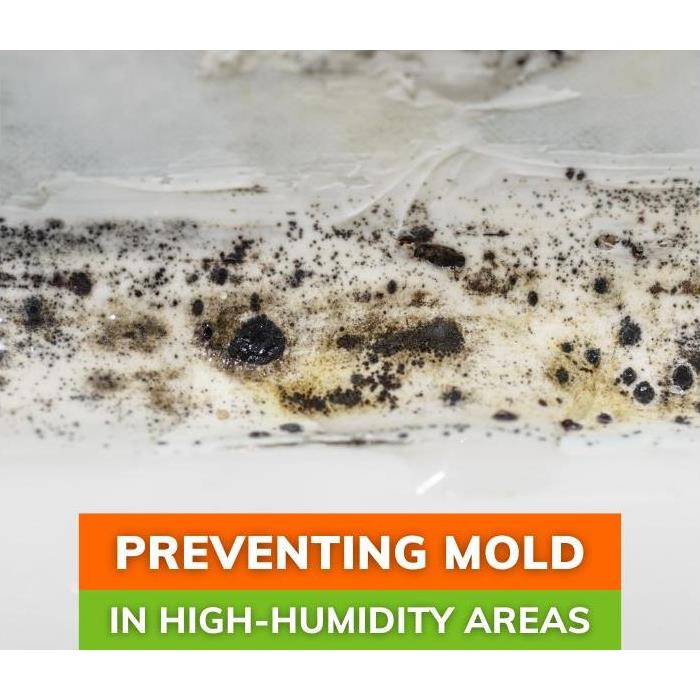 Mold in the wall
Mold in the wall
How to Prevent Mold in High-Humidity Areas of Your Home
Visible mold is more than an eyesore, as it also presents serious health risks and can lead to destructive and costly home damage. In humid areas, fighting mold requires a multi-pronged approach and ongoing diligence. Some practical and effective strategies can go far towards keeping your home mold-free, protecting your family, and bringing peace of mind.
1. Manage Indoor Humidity
Keeping indoor humidity under control is an essential strategy for preventing mold in humid areas of the home. Monitor humidity levels in different areas of the house by purchasing a reliable hygrometer. Invest in dehumidifiers for high-risk rooms such as bathrooms and basements and run them regularly. Condensation from air conditioning units can build up and become a breeding ground for mold, so ensure the HVAC system is properly cleaned, maintained, and functioning.
Keep doors and windows closed during humid weather to keep overall humidity down inside the home. Moisture can come from various sources, including water leaks, so address them immediately to prevent costly damage and mold.
2. Ensure Adequate Ventilation Throughout the Home
Good airflow is essential in keeping rooms dry and free of mold. When rooms do not have adequate ventilation, moisture remains, creating mold growth conditions. To prevent stagnant humidity, use exhaust fans whenever condensation is present in bathrooms and kitchens. If the weather permits, open windows to allow moist air to escape when cooking or showering.
Install ceiling fans to effectively circulate air in any room. Preventing stagnant moisture is all about airflow, so avoid placing large pieces of furniture against walls. Additionally, avoid blocking HVAC vents to ensure air can circulate unobstructed.
3. Repair Leaks and Water Damage Immediately
Even small leaks, if left unaddressed, can allow water to stagnate and create significant mold problems. Inspect plumbing fixtures indoors and out regularly for any signs of leaks. This step becomes critical during winter if temperatures go below freezing and pose a risk of cracked or burst pipes—additionally, seal cracks in foundations and walls to prevent water from seeping in and causing damage.
Damaged roofing materials commonly allow moisture to enter homes, causing leaks in ceilings and walls, significant water damage, and mold. To avoid water intrusion, have the roof inspected regularly and replace damaged shingles, underlayment, and other materials. Mold can grow quickly, so ensure wet areas are dried thoroughly within 24 to 48 hours.
4. Keep Exterior Moisture Where It Belongs
Improving yard drainage is another effective technique for preventing mold in humid areas of the home. Proper drainage can prevent moisture and pooling water from entering your basement and other areas. Ensure that downspouts are positioned to direct water away from the home's foundation. Keep gutters well-maintained and free of leaves and other debris, and inspect and clean downspouts regularly.
It is essential to grade yard landscaping to ensure it directs water away from the house. If pooling water or flooding is an issue in the yard, install French drains or similar systems to manage and redirect excess water. Regularly inspect basement walls for any signs of moisture, and if necessary, seal them appropriately to prevent seepage and manage basement humidity.
5. Upgrade with Mold-Resistant Building Materials
Make a proactive investment in controlling mold in the home by using mold-resistant construction materials for remodels or new building projects. Select mold-resistant drywall or green board for damp areas or those subjected to repeated condensation. Choose mold-resistant paint for cabinets and walls in kitchens and bathrooms. Use wood that has been treated to inhibit mold growth for construction projects.
Choose moisture-resistant flooring materials like vinyl or tile over carpet or hardwood for kitchens, basements, bathrooms, and other rooms with humidity. Finally, moisture barriers should be installed to protect crawl spaces.
6. Clean and Maintain the HVAC System
Mold can spread through an HVAC system via microscopic spores. A clean system ensures effective and efficient humidity control indoors while preventing mold spread. As part of a maintenance routine, replace HVAC filters regularly, especially during seasons when the system gets a lot of use.
Check the HVAC system to see if it has built-in humidity controls to enhance its effectiveness. Schedule a periodic professional duct cleaning, and inspect and check for moisture buildup in HVAC drip pans. Ensure all ductwork is sealed to prevent leaks and minimize condensation.
7. Don’t Overwater Houseplants
Watering house plants may not be an obvious source of humidity that contributes to mold growth, but when plants receive too much water, it does not get absorbed by the plants and stagnates, allowing mold growth. To prevent this issue, use pots designed for good drainage and proper potting mix for household plants to avoid excess water buildup.
Position house plans in well-ventilated areas of the home, and check the moisture level in the soil before adding more water. Avoid creating areas of plant clusters that can hold in moisture and raise the humidity in a room. If plant soil smells moldy or has signs of visible mold, remove the mold immediately and allow the plant to dry out a bit.
8. Safely Prevent Mold with Natural Solutions
Some people wonder how to prevent mold in humid areas of the home while keeping sensitive family members safe. Mold prevention does not need to involve caustic chemicals or expensive cleaners. For simple dehumidification, mesh bags containing charcoal briquettes can be placed in rooms to help absorb excess moisture. White vinegar and tea tree oil are two natural substances that kill mold and make great cleaning solutions when diluted with water.
Improve interior air quality by adding plants such as the Peace Lily, which has been found more effective than the average house plant at purifying the air. Let sunlight in by keeping curtains open to reduce condensation and maintain a drier environment. Avoid using carpets in high-humidity areas to reduce moisture retention and mold.
9. Dry Laundry Properly
If laundry remains in the washer too long, it can become sour and breed mold and mildew. Additionally, using a clothesline or other hanging device to dry clothing indoors can dramatically increase interior moisture levels. To address this issue, hang wet laundry outdoors to dry whenever possible. Avoid hanging damp clothing in humid rooms such as bathrooms and basements.
Use a dehumidifier to keep the laundry area dry, and ensure the washing machine is not leaking or overflowing. The exhaust from a clothes dryer can also increase the humidity in a room, so ensure the dryer vent is connected to the outside.
10. Check Windows and Doors
Windows and doors that do not have a tight seal can become another source of outdoor humidity entering the home. Inspect doors for worn-out weather stripping that might need replacing to keep moisture out. If necessary, install storm doors to help create a barrier to keep the home's interior dry.
Seal gaps around windows using caulk. In some cases, it makes sense to replace windows. Choose energy-efficient or double-pane windows. On humid or rainy days, avoid leaving windows and doors open.
11. Education for Mold Prevention
The individuals managing and overseeing HOAs can play a significant part in reducing mold issues and the associated damage in shared spaces. Start by educating maintenance staff, including developing guidelines for regular common-area inspections to look for water damage and mold signs. HOA managers should encourage routine and proper maintenance of shared ventilation systems, such as those in a clubhouse or business center used by residents.
Enforcing rules and guidelines for swift reporting of water leaks and effective remediation is essential. HOAs can also offer educational information in monthly newsletters for residents on preventing water damage and mold. Sharing this type of information can create an environment of collaboration among residents and help create a mold-free environment for everyone.
Mold and Water Damage Is Serious Business
Mold prevention requires constant vigilance and attention to controlling moisture. Awareness, routine maintenance, and ventilation are reliable strategies to safeguard living spaces and create a healthier family environment. For individuals in humid climates, learning how to prevent mold in humid areas of the home is especially crucial, as these rooms are more likely to experience mold growth.
These proactive techniques enable homeowners to tackle the problem before it gets out of control. If, despite best efforts, mold does appear, contact the mold and water restoration professionals at SERVPRO® to see how we can help. Contact us today!
Steps to Take After Discovering Mold
1/29/2025 (Permalink)
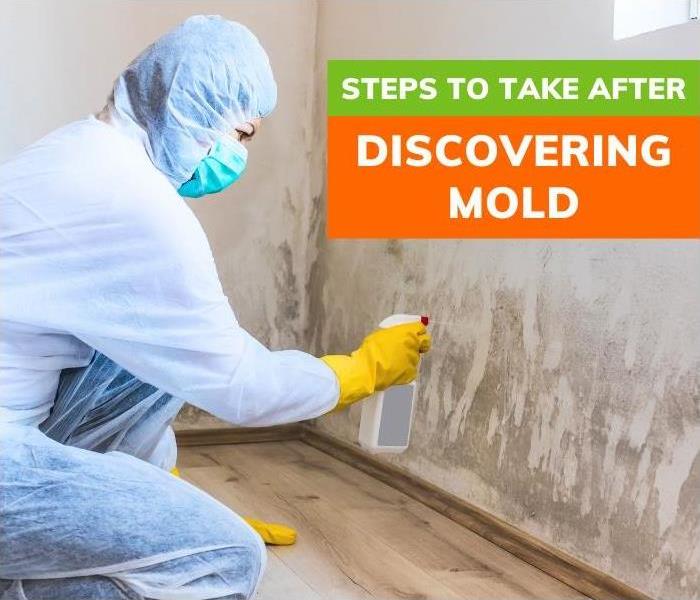 Cleaning mold from the wall
Cleaning mold from the wall
Steps to Take After Discovering Mold
Mold infestations can negatively impact the safety and comfort of homes, rental units, commercial buildings, and more. From damp basements to hidden plumbing leaks, mold thrives in damp, poorly ventilated environments. Effectively managing and preventing mold outbreaks requires understanding their causes and the remediation process. Identifying, addressing, and preventing mold growth pays dividends in improving homes, rental units, and commercial spaces.
Track Moisture Sources
Mold grows and thrives in humid or damp environments, and it is essential to identify the moisture sources causing the problem. Monitor water usage and have pipes checked for leaks. Inspect interior ceilings and walls, and look around windows for signs of leaks or moisture. Externally, check for damaged roofing, such as missing or broken shingles.
Inspect bathrooms, basements, and other areas prone to condensation in the building or home. Monitor humidity levels inside using a hygrometer or other type of moisture sensor. Address and fix any moisture or plumbing issues immediately.
Assess the Problem
The severity of mold growth will dictate how to handle the problem and whether calling in professional help is necessary. Use a tape measure or appropriate app to measure the size of the area affected by mold. Examine ceilings, walls, and floors to look for signs of spreading. Additionally, notice if a moldy smell is present, even if you do not see visual signs of infestation.
Check underneath and behind furniture, under carpets, and other hidden spaces. Mold can hide in unsuspected areas, such as on the back of the wallpaper, wood paneling,g or ceiling tiles. Take photos or videos of the findings for future reference to see whether the problem is worsening or if the mold returns once the situation is resolved.
Isolate the Mold
Mold spores are visually undetectable and can travel and spread to new areas. Steps to take after discovering mold include keeping spores contained for effective management and removal. Seal off areas that contain mold by using plastic sheeting or drop cloths and duct tape to secure them. Close off HVAC vents in the affected area, especially since mold spores can travel through HVAC vents and into other areas of the home or building.
Air purifiers that use HEPA filters can capture airborne mold spores, making them an essential addition to the HVAC system. Alert family members or tenants about the contaminated space and ask them to avoid entering or disturbing it.
Wear Safety Gear
Invisible mold spores can cause respiratory issues and other problems, so put safety first by wearing protective gear when handling mold removal.
Use a respirator or an N95 mask to protect from inhaling mold spores that become airborne during removal.
Additionally, avoid touching mold with bare hands and wear long-sleeved clothing, goggles, and gloves. Remember to discard contaminated protective gear, such as masks, after use.
Mold and Rental Properties
Mold problems can go unnoticed and escalate in rental properties, especially when experiencing high tenant turnover. Have the property inspected thoroughly as soon as existing tenants move out. Educate new tenants about mold issues and the importance of promptly reporting water leaks and mold sightings.
Keep maintenance records to identify units with recurrent mold issues. For problem areas, implement proactive measures such as dehumidifiers in units prone to mold development.
Removing Visible Mold
Removing all visible mold from building surfaces is essential for restoring a healthy, clean living environment and is one of the crucial steps to take after discovering mold. Use detergent or a solution of vinegar and water, or for more challenging problems, use a commercial product formulated for mold removal.
Non-porous surfaces such as metal and tile can be scrubbed with a brush. If porous materials, such as carpet or drywall, are beyond salvaging, they must be discarded. Wherever mold has been present, the areas require thorough cleaning to prevent regrowth.
Dry Affected Areas
Eliminating moisture and humidity ensures mold does not regrow after the remediation process. Dry surfaces externally using dehumidifiers and fans. If the weather permits, open windows for fresh air and ventilation.
Using a moisture meter, check for any residual moisture in the affected area. Give cleaned and repaired spaces adequate time to dry completely before painting or sealing. If mold or dampness remains, the paint or sealant will eventually peel.
Ensure a Thorough Cleanup
Flooded areas of a home, rental unit, or commercial building may appear fine after the initial dry-out period. However, failing to remove all contaminated materials can increase health risks and reduce air quality. In addition to mold, wet materials and standing water are breeding grounds for bacteria and other microorganisms, such as viruses.
These pathogens can trigger allergic reactions, cause diseases, and contribute to damage that continues long after the initial flood cleanup.
If contaminated water or sewage causes mold or water damage, consider hiring a professional service to handle the cleaning and repairs.
Mold in the HVAC System
Mold spores can travel and spread through air ducts, making an HVAC system a potential source of problems. Inspect the HVAC system's filters, coils, and vents for dust build-up or signs of mold. Replace the HVAC system's filters regularly to ensure improved air quality.
Consider professional duct cleaning if the HVAC system is especially dusty or heavily contaminated. Condensation can also build up in ducts, so ensure proper cleaning and maintenance to prevent the conditions that trigger mold growth.
Monitor for Signs of Recurrence
Maintaining ongoing vigilance, especially in known problem areas, is essential to avoid a repeat mold infestation. Steps to take after discovering mold include scheduling periodic inspections of any areas that have had mold issues. Look for any discoloration, pay attention to areas that smell moldy, and look for visible signs of mold regrowth.
Install moisture or humidity sensors to provide an alert if high moisture levels occur. Act promptly at the first signs of mold or moisture to get the area dried out and clear of mold.
Catch Water Damage and Mold Promptly
Mold can cause property damage and illnesses that can become extremely costly to resolve. Addressing mold requires vigilant inspections, thorough cleanup, and effective prevention measures.
Identifying moisture sources and isolating mold are the first essential steps in remediation. Ensuring the affected areas are properly dried and treated is the best insurance to prevent the problem from reoccurring. Whether tackling a minor mold-growth issue or handling extensive damage, remember that water intrusions come in many forms and are the most common root of mold problems.
Swift action to identify and resolve the issues protects properties and makes them safer for all parties. When you need the expertise of professional mold remediation, SERVPRO® has the experience and equipment to handle the job. Contact us today to find out more.
Ways to Prevent Mold Growth in Humid Areas
12/21/2024 (Permalink)
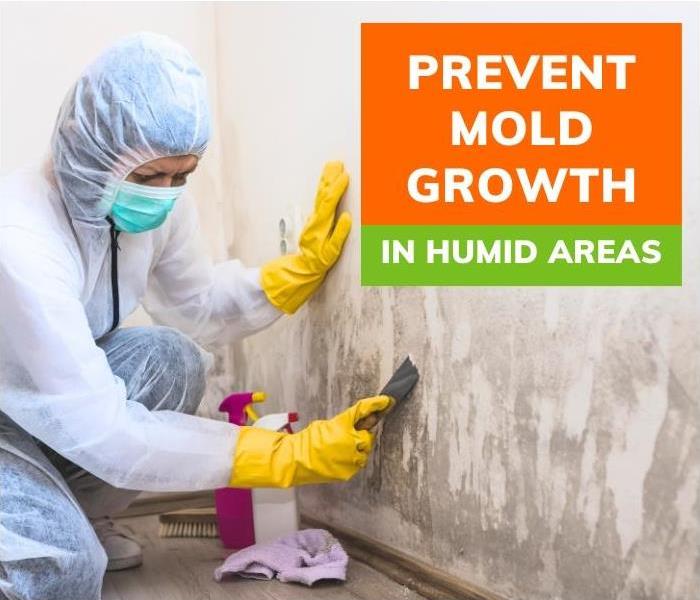 Professional cleaning mold
Professional cleaning mold
Ways to Prevent Mold Growth in Humid Areas
Mold is one of the perils that can affect any commercial or residential building, especially during the humid and rainy seasons each year. Preventing mold growth is crucial because once it takes hold in a building, it can significantly worsen air quality and cause damage to walls, ceilings, and more.
Mold can trigger allergic reactions, asthma attacks, and other respiratory issues. If not properly managed, the toxins and allergens produced by mold can cause significant health issues for occupants, especially those with compromised immune systems.
Where Mold Grows and Why
Mold often thrives inside building areas that have little air circulation and high moisture. These areas include kitchens, bathrooms, basements, laundry rooms, and window frames. Mold might be less of a problem in newer construction, while older buildings often have less effective ventilation and insulation, creating ideal conditions for mold to grow.
Keeping indoor spaces dry enough to prevent mold growth is challenging for buildings in a humid climate with consistent rainfall or those that have sustained water or fire damage. To make matters worse, mold spreads easily through microscopic spores, so once it grows in one area of a building, it can move invisibly to other damp spots if not managed and controlled properly. Fortunately, there are several ways to manage dampness to prevent mold from growing in the first place.
1. Increase the Space’s Ventilation
Fresh air is mold's enemy, while stagnant air allows moisture to settle, feeding mold growth. Install exhaust fans in areas with high humidity, such as bathrooms and kitchens, to keep air moving and prevent mold from growing.
Ceiling fans are another important way to improve air circulation and can work in any room or area prone to dampness. Opening windows as the weather allows is another easy way to increase room ventilation and prevent the moisture accumulation that triggers mold growth.
2. Use Dehumidifiers
Dehumidifiers are highly effective tools for reducing room humidity and preventing mold from growing with regular use. Preventing mold growth in humid areas can be as simple as placing a dehumidifier wherever a building has minimal ventilation, such as in a basement, in storage closets, or by windows that often have condensation.
To prevent mildew from growing, ensure the dehumidifier tank is emptied and cleaned frequently. The optimal humidity is about 50% inside, so the dehumidifier should be set accordingly to provide the best results.
3. Keep Furniture Away from Interior Walls
Mold loves stagnant air and trapped moisture, and furniture close to walls can create a perfect environment of blocked airflow that encourages mold growth. Keep furniture a few inches from walls, and educate tenants on leaving this small space so the air can circulate.
Large items, such as bookshelves and dressers, must be kept slightly away from walls because their large size increases the potential for trapping moisture and blocking airflow. For commercial property managers, communications such as a monthly tenant newsletter can offer tips and guidance on arranging interior furniture to maintain optimal ventilation and prevent setting up conditions for mold growth.
4. Use Mold-Resistant Products
Products especially made to resist or prevent mold growth can make a big difference in high-risk areas. Consider using paints made to be mold-resistant, which often means they contain an additive that acts as a mildewcide.
Suggest tenants use mold-resistant liners and shower curtains in their bathrooms. When undertaking renovations in areas that have already suffered from mold and moisture damage, use mold-resistant drywall for the repairs to prevent future damage.
5. Install Proper Door and Window Insulation
When a building has gaps around doors and windows, moisture finds its way in and settles into building materials and rooms with little airflow. Inspect door frames and windows, looking for cracks or gaps. Seal these with new caulking or weather stripping.
Ensure to check doors that lead to the outside, such as front and sliding glass doors, as inadequate seals can allow condensation to build up on the inside, especially on glass doors. If condensation is an ongoing problem, consider installing double-pane windows, which help keep indoor rooms dry and mold-free by reducing the amount of condensation that forms.
6. Clean HVAC Vents and Filters Regularly
If a building has mold, the HVAC system may have spores in its filters that can promote mold growth in the system and a building's rooms. Dirty or dusty HVAC systems can also trap moisture, increasing the chances of mold growth.
Preventing mold growth in humid areas such as air ducts may involve replacing the HVAC filters every one to three months, depending on the severity of moisture or the presence of mold. Also, consider having the HVAC system cleaned professionally once each year, and as part of a regular maintenance schedule, dust and vacuum around vents to keep air flowing freely.
7. Perform Regular Leak Inspections and Repairs
Water leaks can go unnoticed for months, leading to moisture behind furniture or under flooring such as carpet. Mold can grow and spread, eating away at flooring materials and drywall in the meantime. Look for discolored walls, ceiling stains, or bubbling drywall, which can indicate hidden water leaks, or contact a SERVPRO® professional for an inspection.
What is SERVPRO? They are a leader in water and fire damage restoration, and they can help tackle minor leaks to major moisture issues before mold has time to settle in. Sometimes, there may not be any sign of mold or water damage, but an area can have a noticeable mold or mildew smell. Repair any hidden leaks immediately and dry out the affected area to prevent mold from getting established. Regularly check areas where water commonly makes its way into buildings, such as pipes, window seals, and roofs, for signs of leaks or water damage.
8. Dry Wet Surfaces Immediately
Since mold can start growing on wet surfaces within 24 to 48 hours, drying out the moisture immediately is critical. A monthly tenant newsletter for rental properties can include tips such as wiping down showers, sinks, and counters after each use to minimize the moisture that feeds mold.
Another tip is to use a squeegee to quickly and easily remove water from shower doors and walls after each use. Also, remind tenants that bath mats and towels can become a moist area for mold or mildew growth and to keep them dry and clean.
9. Manage Humid Areas with Absorbent Materials
Absorbent materials can help minimize moisture levels in small spaces such as coat closets and cabinets. Some moisture-absorbing products on the market include silica gel packets or crystals packaged for easy and safe use in a closet or cabinet. These products absorb moisture continually. Baking soda or charcoal are two additional low-cost materials that can absorb moisture naturally.
These moisture-absorbing materials need refreshing periodically because they become saturated over time. Consider installing a hygrometer, a device that monitors humidity levels, in rooms with a higher risk of humidity and mold growth, such as basements and bathrooms. Aim to keep the humidity levels below 60% and ideally around 50%. Use dehumidifiers and fans to adjust and optimize the humidity levels.
10. Address Frequent Window Condensation
When condensation forms on windows, it can drip down into window sills and surrounding areas, creating a moist environment for mold to grow. Keep the area dry by wiping down the condensation daily, especially during humid times like winter. Keeping the windows slightly open helps with air circulation and minimizes condensation. Property managers or landlords can offer tenants instructions on using a vent lock or other device to keep windows slightly open but still locked for safety reasons.
Also, consider installing a window insulation film to reduce condensation buildup during colder months. Sunlight naturally prevents mold because it dries out moisture, preventing mold growth in humid areas. Suggest that tenants keep their curtains open during the day and keep blinds open to allow for airflow around windows to minimize condensation. Also, consider adding window coverings that are mildew-resistant, such as shades or blinds, instead of fabric curtains.
11. Room Décor Makes a Difference
House plants can add a lot of benefits to interior spaces, although they also increase the humidity indoors, especially in small rooms. Keep house plants out of bathrooms, and avoid placing them too close to walls where they can trap moisture and breed mold. Choose plants that do not require a lot of water, which will minimize moisture in the room. Low-maintenance plants that do not require a lot of water, such as succulents, make better house plant options to maintain a less humid environment indoors.
Wall-to-wall carpeting absorbs moisture, creating an ideal environment for mold to grow. Avoid placing carpeting in basements, bathrooms, and other high-humored rooms. Vinyl or tile flooring is a better option for areas at risk for mold, and area rugs make a better decorating choice because they are easily removed for cleaning when necessary.
Prevent Mold with a Multi-Pronged Strategy
Preventing mold growth in humid areas can present several challenges. However, with the right strategies, it becomes entirely manageable, no matter what time of year or weather conditions exist. If you are a property owner or manager dealing with commercial water, fire, or mold damage, our experienced professionals can provide solutions tailored to your property’s needs. Contact us today to find out how SERVPRO can help!
How to Identify Mold in Your Property
10/14/2024 (Permalink)
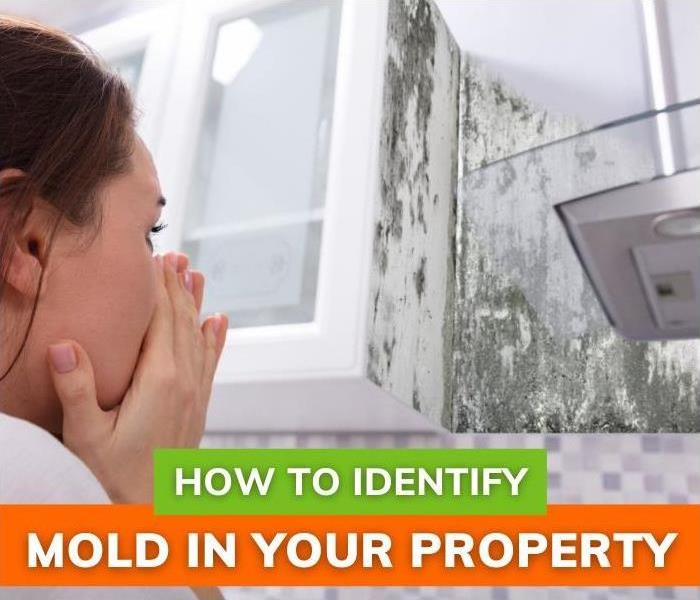 Woman discovers mold at home
Woman discovers mold at home
How to Identify Mold in Your Property
Mold: An Unseen Problem in Your Home
Mold is a type of fungi commonly found in areas with sufficient moisture. It thrives in environments with excess humidity, oxygen, and organic material to feed on, such as wood or drywall. While mold is a natural part of the environment, when it begins to grow indoors, it may indicate a moisture problem that needs to be addressed to prevent long-term damage.
Is Mold Dangerous?
While mold is a naturally occurring organism, its presence indoors often signals a moisture issue that can impact your property. Uncontrolled moisture exposure can cause wood rot, compromising the integrity of structural elements like walls, floors, and ceilings. Additionally, areas of your property with ongoing mold growth often indicate underlying issues such as plumbing leaks or ventilation problems, which may require further investigation and remediation.
Although the term “black mold” is widely used in media and by the public, it’s more effective to focus on identifying and addressing mold growth, regardless of color or appearance. All types of mold can contribute to material deterioration in the presence of ongoing moisture, making early identification and remediation critical for maintaining the safety and stability of your property.
Common Signs of Mold Presence
Identifying mold early is key to preventing widespread damage. Here are some common signs that may indicate mold growth in your home or business:
Musty Odors in the Air
One of the earliest indicators of mold growth is an earthy or musty smell. This odor may be subtle or strong, depending on the extent of the growth. Many describe the scent as similar to damp wood, old paper, or wet socks. This scent is often caused by releasing volatile organic compounds (VOCs) as mold colonies grow.
However, tracking mold by smell alone can be challenging. Musty odors do not always reveal the exact location of mold, as the scent can permeate through walls, floors, and other materials. A large patch of mold hidden behind drywall or under flooring, for example, can create a pervasive smell throughout an entire section of a house. Professionals use specialized tools to pinpoint and address the source of the scent, making it essential to involve experts when a musty odor is persistent.
Visual Indicators of Mold Growth
When identifying mold visually, it’s essential to recognize that mold can appear in many forms and colors, not just the familiar black or green patches. Depending on the species and environmental conditions, mold growth can appear as spots or streaks in shades of white, yellow, orange, brown, or even pink. Moreover, the same area may display multiple colors, making it crucial to regularly inspect areas of your property prone to moisture accumulation.
Mold spores are microscopic, meaning you may not notice mold growth until a significant amount has accumulated. To catch mold problems early, it’s important to periodically check high-risk areas like bathrooms, kitchens, basements, and crawlspaces. Don’t forget to look under sinks, behind toilets, around windows, and in corners, as these places often harbor small but growing colonies.
Increasing Allergy-Like Symptoms
Residents of homes with mold might experience more frequent allergy symptoms, particularly in spaces with high humidity. While seasonal changes and environmental factors may also play a role, persistent symptoms like coughing, sneezing, or eye irritation may indicate mold, especially if they occur or worsen in certain rooms or locations.
One challenge of identifying mold based solely on physical symptoms is that other factors, such as pollen, dust mites, or pet dander, can cause similar reactions. Nevertheless, if symptoms are more severe in particular rooms or coincide with periods of high humidity, it’s worth considering a professional assessment.
Where to Look for Mold
Knowing where to look for mold is just as important as knowing what to look for. Mold thrives in dark, damp environments, so targeting these areas during routine inspections can help catch mold before it spreads. Here are some key areas to monitor:
Basements and Crawlspaces
Due to their location and relative lack of sunlight, basements and crawlspaces are particularly vulnerable to mold growth. Poor ventilation and high humidity levels create an ideal environment for mold to thrive. If your basement or crawlspace has experienced past water damage, mold growth may be especially likely.
Bathrooms and Kitchens
Bathrooms and kitchens are notorious for mold and mildew growth because of their wet environments. Water from showers, sinks, and cooking activities can lead to damp surfaces and excess humidity, providing a fertile breeding ground for mold. Pay special attention to areas around caulking and grout, as gaps allow moisture to seep in and remain trapped.
Window Sills and HVAC Systems
Window sills often collect condensation, resulting in mold development, particularly in older windows with compromised seals. Mold can also thrive inside HVAC systems, circulating air throughout your property. Regular window cleaning and HVAC maintenance are key preventative measures to stop mold from taking hold.
Mold Growth After Fire or Water Damage
In addition to routine checks, you should be extra vigilant after any incidents involving fire damage or water damage. Even after the initial damage has been addressed, lingering moisture from water used in fire suppression or from leaks can create a breeding ground for mold. Be sure to inspect affected areas thoroughly after such events to catch potential mold growth early.
How to Reduce the Potential for Mold Growth
Preventing mold from taking hold on your property requires vigilance and proactive measures. While no prevention strategy can guarantee that mold will never develop, you can take steps to reduce the risk.
Clean Spills Promptly
Because mold thrives in wet environments, it’s crucial to address spills quickly and thoroughly. This includes spills on carpets and rugs, which can harbor moisture beneath their surface. Even small spills, if left unattended, can lead to mold growth over time, so clean and dry any affected areas as soon as possible.
Keep Bathroom and Kitchen Areas Dry
Bathrooms and kitchens are often prone to mold because of their wet conditions. Regularly inspect these areas and ensure caulking around tubs, showers, and sinks is in good condition to prevent moisture from seeping into walls or flooring. Wipe down surfaces regularly, use fans to improve air circulation, and consider installing exhaust fans if humidity levels are consistently high.
Use Dehumidifiers
Dehumidifiers help control humidity levels, making it harder for mold to grow. Depending on the size of the space, these devices can be installed as portable units or as part of your home’s HVAC system. In areas like basements, where humidity levels can be particularly high, a dehumidifier can be a simple and effective way to reduce the risk of mold growth.
For properties with recurring mold issues, whole-house dehumidification systems can be installed by an HVAC professional to maintain optimal humidity levels. Additionally, homeowners dealing with crawlspace issues might consider encapsulation, which creates a barrier to inhibit moisture from entering these vulnerable areas.
Regular Inspections and Mold Testing
If you’re concerned about the potential for mold growth or have experienced repeated issues, consider scheduling routine inspections with a professional restoration company. Experts can identify areas of concern and provide tailored solutions based on your property’s specific needs.
In some cases, you might also consider using mold testing kits, which can detect the presence of mold spores on your property. Although these kits provide a basic indication of mold, they are not as reliable or comprehensive as a professional inspection. If mold is found, it’s best to work with a trusted restoration company to address the problem.
Mold Spores Can Be Hidden Inside Porous Materials
Mold growth isn’t always on the exterior of surfaces, at least not in an obvious way. Porous materials, such as drywall and wood, can harbor mold spores inside their cracks and crevices, making them difficult to detect without proper tools and techniques. Even if you’ve cleaned and dried the exterior, mold can still grow internally, so consulting a professional is crucial.
When to Contact Professionals
If you suspect mold growth in your property, it’s essential to act quickly to prevent the problem from escalating. Contacting a professional restoration company, such as SERVPRO®, can ensure that all affected areas are thoroughly inspected, cleaned, and remediated. Professionals use specialized equipment to detect and remove mold safely and effectively, reducing the risk of recurrence.
SERVPRO of Arcadia: Your Mold Remediation Experts
If you’re dealing with mold growth in your home or business, don’t take risks—contact SERVPRO of Arcadia for fast and reliable fire damage restoration Arcadia and mold remediation services. We’re equipped to handle moisture problems and ensure your property is safe and secure. In addition to mold remediation, SERVPRO provides comprehensive fire and water damage restoration services, helping you get back to normal as quickly as possible.
Tackling Mold Growth after Rains
6/20/2023 (Permalink)
Rainy days bring much-needed water to our gardens and help cool down warm temperatures. However, they can also bring an unwanted guest into our homes: mold.
The problem with mold is that it thrives in damp conditions. When heavy rains strike, water can find its way into your home through leaks in your roof or windows, or even through your home's foundation. These damp conditions are a breeding ground for mold spores, which can rapidly multiply and spread if left unchecked.
Not only is mold unsightly, but it can also cause serious health issues, such as respiratory problems, allergic reactions, and in severe cases, even neurological damage. Furthermore, it can cause substantial structural damage to your home, affecting its value and livability.
At SERVPRO of Arcadia, we understand the urgency of addressing mold problems. If you've recently experienced heavy rain and are worried about potential mold growth, our team of certified experts is ready to help.
Our comprehensive mold remediation process begins with a thorough inspection to detect any signs of mold. We then isolate the affected areas to prevent the spores from spreading during the removal process. Our team utilizes advanced techniques and equipment to thoroughly clean and treat the area, ensuring the mold is eliminated.
But we don't stop there. At SERVPRO of Arcadia, we believe in proactive prevention. We'll help identify areas in your home vulnerable to water damage and provide you with effective strategies to prevent future mold growth.
Remember, mold is more than an unsightly nuisance. It's a potential health hazard and a sign of water damage. After the rain, don't let mold spoil the freshness. Call on SERVPRO of Arcadia – your partner in mold remediation and water damage restoration.
Water Damage Turned into Mold
9/14/2021 (Permalink)
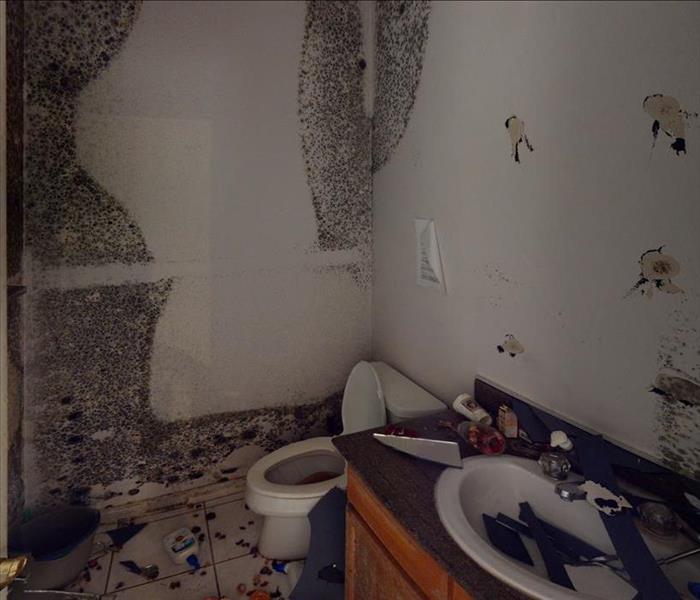 Extensive mold discovered
Extensive mold discovered
Ever wonder what would happen if you left a water damage unaddressed? Well, this would be your worst case scenario. When water damage is not properly mitigated or ignored for several months (even years), mold is almost guaranteed to grow and multiply into what you see here.
It is best to be sure to monitor your plumbing systems to catch any sign of water damage early on. Proper maintenance of pipes, faucets, toilets, sinks, etc.. is very important in preventing mold from growing.
When dealing with mold in your home it is very important NOT TO:
- Touch or disturb the mold.
- Blow air across any surfaces with visible or suspected mold growth.
- Attempt to dry the area yourself.
- Spray bleach or other disinfectants on the mold.
Thankfully, our technicians are certified in Applied Microbial Remediation by the IICRC. They have extensive experience in mold remediation and could handle any size remediation. It is recommended that you always let a professional assist with Mold Remediation.
Feel free to contact SERVPRO of Arcadia at 626-447-4128 for more information on how to help you with your mold remediation.
Breaking the Mold
1/15/2020 (Permalink)
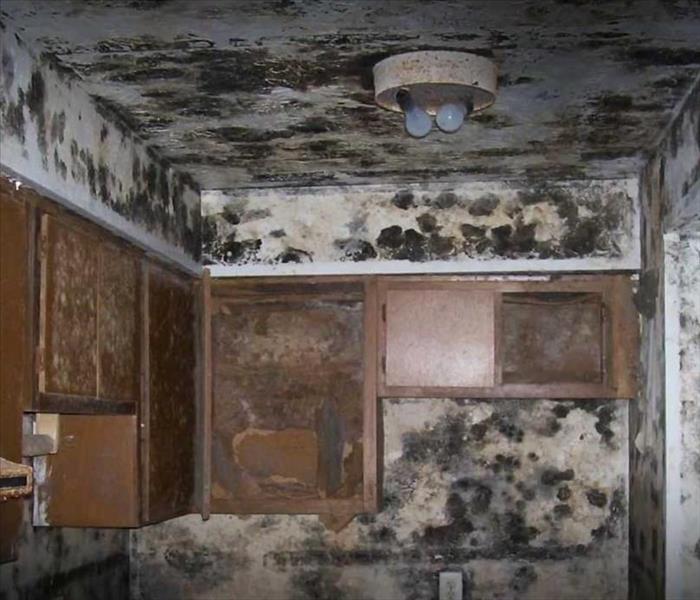 Mold Problems
Mold Problems
Mold is commonly found in most places in our environment like our homes and we may not even know it. Mold can be a serious problem in your home or business because it can spread quickly.
Is having mold in your home a health hazard?
Yes, mold can cause various health effects. Especially to children, and those with comprised immune systems, such as elderly persons and those with respiratory problems.
What causes mold?
Mold can be caused by a variety of water intrusion problems like a roof leak or leaking water line that is not taken care of.
Mold Tips
To prevent mold you should:
- Reduce moisture levels in your bathroom by running a fan during and after your shower.
- Increase airflow in your home by opening windows.
- Fix plumbing issues like leaks to prevent moisture problems and water damage from accruing because water damage is the main source for mold growth.
- Cleaning, disinfecting and drying surfaces daily.
When dealing with mold in your home it is very important NOT TO:
- Touch or disturb the mold.
- Blow air across any surfaces with visible or suspected mold growth.
- Attempt to dry the area yourself.
- Spray bleach or other disinfectants on the mold.
What to Do:
- Stay out of affected areas.
- Turn off the HVAC system and fans.
- Contact SERVPRO of Arcadia for mold remediation services at (626) 447-4128
Got Mold? We got a Crew!
1/15/2020 (Permalink)
 We have certified technicians available to remediate. Call us for an estimate. You will be glad you called.
We have certified technicians available to remediate. Call us for an estimate. You will be glad you called.
Believe it or not, you’re exposed to mold every day. Some forms of mold you can see, however there are many that you can’t. Whether it grows on your walls, floor boards or even your shower curtains, mold is an unappealing sight to look at. Some people don’t pay any mind towards the mold and just let it grow. Having mold in your home can cause an issue for health effects, especially for those who are prone to allergies, asthma, or respiratory conditions. That is why we here at SERVPRO of Arcadia, have technicians who specialize in mold remediation, so that we can take care of your mold problem. Our crew members take extreme precaution to ensure that we remove every last bit of the mold so you and your loved ones are not affected by it. Mold is our cornerstone. We take it very seriously.
Water Mitigation Leads to Mold Remediation
1/22/2018 (Permalink)
A job usually turns into a mold remediation after the affected area has experienced some type of water damage. That’s why it’s important to contact SERVORO right away to get started on fixing the problem before it gets worse.
Primary loss site is the kitchen. The walls and cabinets in the kitchen had high moisture readings. We had then learned that the water traveled to other rooms, so we immediately ran our moisture tests and discovered moisture in the other rooms. Once we got permission to remove the hard would floor, we saw that mold had started to grow. The picture is of mold underneath a staircase where the water traveled down to. The mold remediation process has now begun. Our technicians must remove the mold off both the walls and studs. Mold remediation must be done with extreme caution to ensure the mold can’t affect any other areas.
What You Should Know About Mold
1/22/2018 (Permalink)
Mold is very interesting, but gross at the same time. We here at SERVPRO want you to know if you have a mold problem, we can take care of it. However, there are some things about mold that you should know. When you hear the term "black mold", you may think that its very harmful. What you should know is that mold can be all colors and its color doesn't dictate how harmful it may be. The color of mold may vary, due to whatever type of material it is consuming. Mold releases spores and may cause an allergic reactions, no matter what color or what type of mold it is.
Just keep in mind SERVPRO of Arcadia, has highly trained technicians who specialize in mold remediation.
What is Mold?
1/11/2018 (Permalink)
Mold is a type of fungus. It can be found both indoors and outdoors. Research has shown that mold grows best in humid, warm and moist environments. Mold commonly occurs in homes during the winter because of the significant amount of moisture in the air. Below are the common types of molds found indoor.
- Aspergillus - grows on dust, food made from powder, and most commonly found on drywall.
- Cladosporium - can grow in both cool and warm environments and is typically found on fabric and on the surface of wood.
- Penicillium - often has a blue or green color and is typically formed on objects that have been affected by water.
- Alternaria - is found in most common damp areas, such as showers or under sinks.
SERVPRO of Arcadia is open 24-hours, don’t hesitate to call us at anytime. We can have a team of professional technicians, to start on your mold remediation right away. We’ll make it, “Like it never even happened.”
Don't Let Mold Trick You
1/11/2018 (Permalink)
The beginning of the year, usually starts us off with cold and wet weather. Durning these times, you may notice an increase of moisture in your home. Wether it be on your walls, books, clothes, your child’s toys, mold can grow there. Mold is easier to deal with because you can see it. However, mold spores can be found everywhere and they’re invisible to the naked eye. Spores are found both indoors and outdoors and can travel through your home in many different ways. For example, open windows and ventilation systems are primary ways mold spores can enter your home. The way mold begins to grow is only if the spores were to land on a surface where there’s an excessive amount of moisture. As a reminder, SERVPRO of Arcadia specializes in Mold Remediation. Give us a call today for a free estimate (626) 447-4111.
Signs of Mold
1/8/2018 (Permalink)
How can you tell if you have mold in your home? Mold has a very distinct and musky smell to it. If you start to notice a very disturbing smell coming from certain walls or platforms in your home, the chances are mold is growing in that area. However, in order to determine whether or not you have mold in your home, an environmental testing company must do the proper tests for our technicians to operate. As you may know, mold can get you sick. It is best that you stay away from the affected area and under no circumstances should you touch mold or clean it yourself. Being exposed to mold can cause excessive sneezing, runny noses, red eyes and even rashes. That’s why it’s best that you call a professional like SERVPRO of Arcadia, who have the proper knowledge, equipment and highly trained technicians that specialize in mold remediation. We take pride in resolving your mold issue and leaving it, “Like it never even happened.”
Jack O' Lantern
10/4/2016 (Permalink)
Halloween is around the corner. SERVPRO of Arcadia would like to share some tips on how to keep your Jack O' Lantern (Pumpkin) from getting moldy fast!
Follow these easy steps:
- After your pumpkin has been carved, rinse it out with water to get rid of excess strings and gunk.
- Take a large bucket or tub and fill it with three gallons of water.
- Stir three teaspoons of bleach into the water.
- Dunk in the pumpkin.
- Then you add silica by removing the top of the pumpkin. Take a silica bead and embed it into the interior of the pumpkin. Do not stick the bead in so far that it changes the appearance of the pumpkin's exterior.
Silica packets are largely available with the following items:
- Beef jerky
- Shoes and shoe boxes
- Cat litter
- New purses or wallets






 24/7 Emergency Service
24/7 Emergency Service








